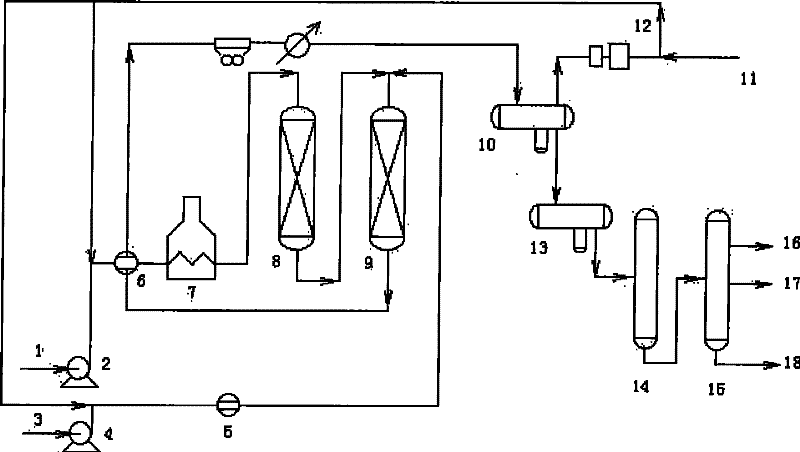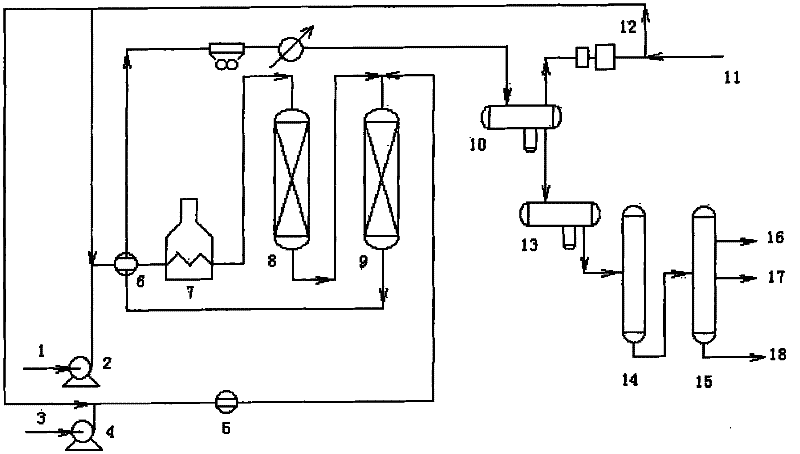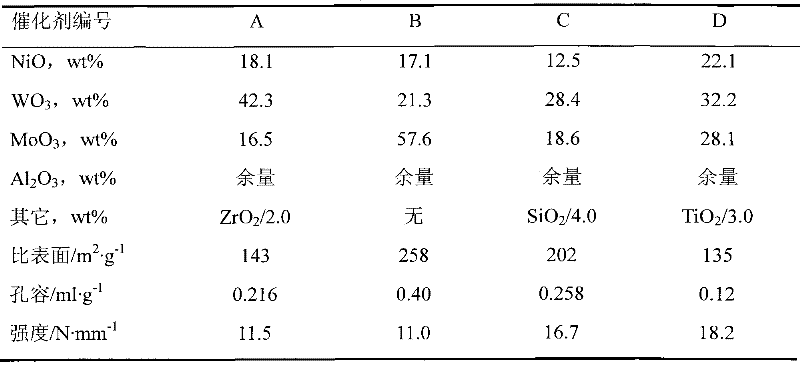Cycloalkyl secondary processing gasoline and diesel hydrogenation method
A technology for secondary processing, naphthenic crude oil, applied in hydrotreating process, petroleum industry, treatment of hydrocarbon oil, etc., can solve the problem of difficulty in obtaining high-quality light products, single hydrogenation products, low cetane number, etc. problem, to achieve the effect of low total investment and operating cost of the device, increase dry point, and increase cetane number
- Summary
- Abstract
- Description
- Claims
- Application Information
AI Technical Summary
Problems solved by technology
Method used
Image
Examples
preparation example Construction
[0031] The preparation process of bulk catalyst of the present invention comprises the following contents: (1) co-precipitation method generates Ni x W y o z Complex oxide precursors; (2) Ni x W y o z Complex oxide precursors and MoO 3 Beating and mixing, filtering; (3) forming and activating the final catalyst.
[0032] Wherein (1) described coprecipitation method generates Ni x W y o z The process of the precursor of the composite oxide can adopt the following method: add the salt solution containing tungsten and nickel into the glue tank according to the required ratio of the catalyst composition, and add the precipitant to make the gel mixture. The precipitating agent can be an inorganic or organic basic ammonia compound, preferably ammonia, and any concentration of ammonia water can be used.
[0033] The required catalyst aids and additional components can be added in one or more of the above steps. Auxiliaries generally include one or more of P, F, Ti, Si, B, Z...
Embodiment 1
[0045] Add 1000mL of water into the reaction tank, then add 40g of nickel chloride to dissolve, then add 52g of ammonium metatungstate to dissolve, then add 5g of zirconium oxychloride to dissolve, then add 10% ammonia water to form a gel until the pH value is 8, and then gel The temperature is 50°C, aging for 1 hour after forming the gel, and then filtering, adding 600ml of clean water, 16g of molybdenum trioxide and 32g of aluminum hydroxide to the filter cake, beating and stirring evenly, filtering, drying the filter cake at 80°C for 5 hours, and then extruding Molded, washed 3 times with clean water, dried at 120°C for 5 hours, and calcined at 500°C for 4 hours to obtain the final catalyst A. The composition and main properties are shown in Table 1.
Embodiment 2
[0047] According to the method of Example 1, according to the component content ratio of catalyst B in Table 1, add aluminum chloride, nickel chloride, sodium tungstate in the reaction tank, then add 16% ammonia water to form a gel, until the pH value is 9 , the gelling temperature is 80°C, aging for 3 hours after gelling, then filtering, washing the filter cake twice with 500mL clean water, adding clean water and molybdenum trioxide, beating and stirring evenly, filtering, and drying the filter cake at 70°C for 7 hours , and then extruded, washed twice with clean water, dried at 100°C for 8 hours, and calcined at 550°C for 3 hours to obtain the final catalyst B. The composition and main properties are shown in Table 1.
PUM
 Login to View More
Login to View More Abstract
Description
Claims
Application Information
 Login to View More
Login to View More - R&D
- Intellectual Property
- Life Sciences
- Materials
- Tech Scout
- Unparalleled Data Quality
- Higher Quality Content
- 60% Fewer Hallucinations
Browse by: Latest US Patents, China's latest patents, Technical Efficacy Thesaurus, Application Domain, Technology Topic, Popular Technical Reports.
© 2025 PatSnap. All rights reserved.Legal|Privacy policy|Modern Slavery Act Transparency Statement|Sitemap|About US| Contact US: help@patsnap.com



